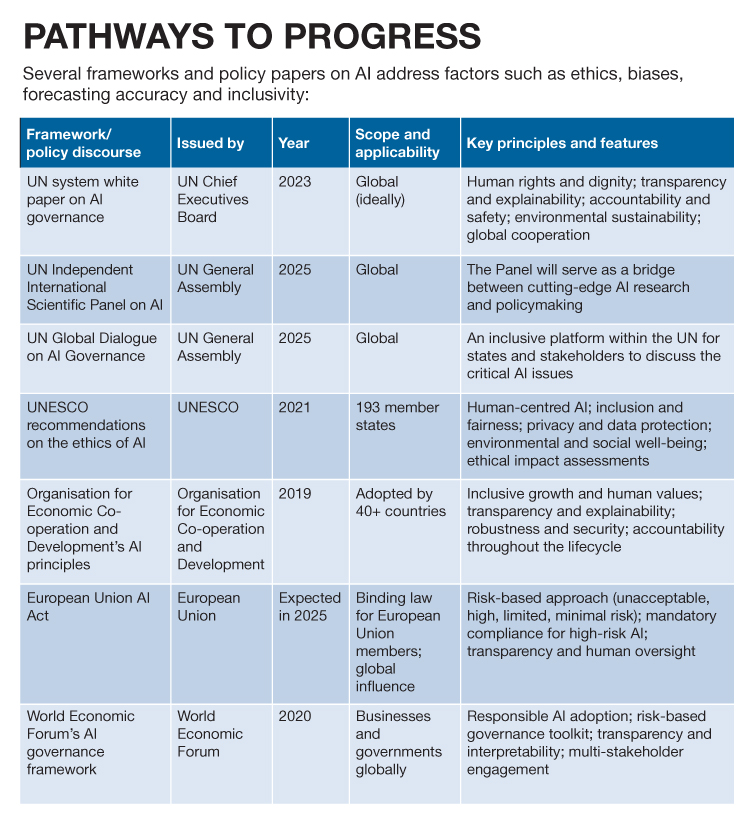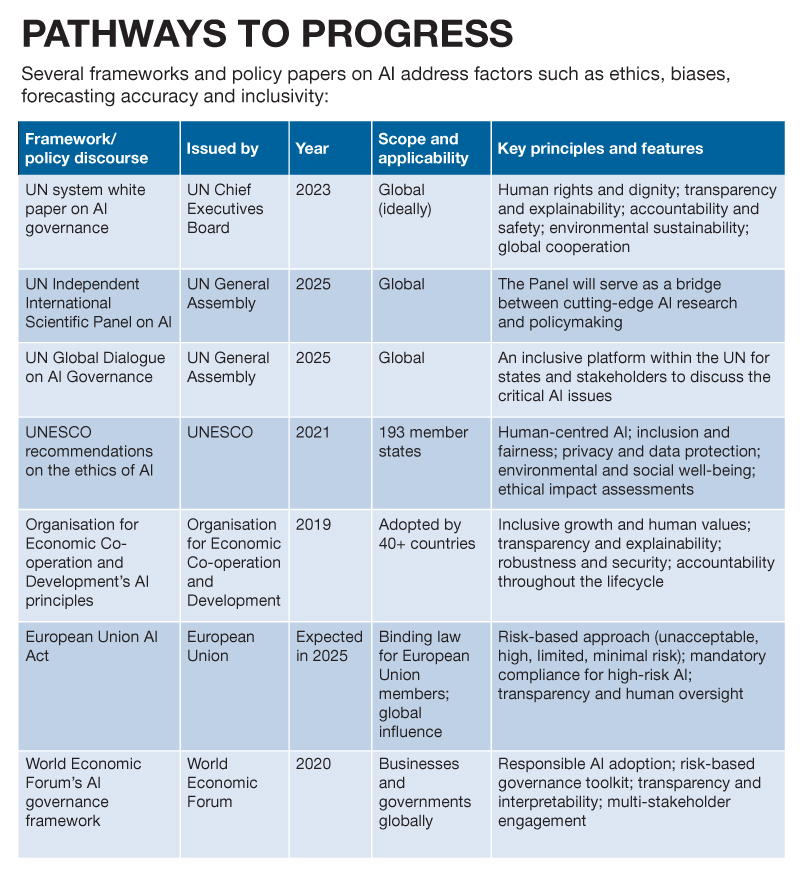AI for social good: Promises and praxis
Artificial intelligence can do a world of good for society and its systems if used ethically and with care, but pulling that off is far from straightforward
‘Singularity’ is not just a random word; it’s one with a deep underlying meaning. It was first used in 1873 by physicist James Maxwell in a different context, but now it’s widely used with reference to technological singularity, which refers to a hypothetical point when artificial intelligence (AI) surpasses human intelligence. Some argue that we will see this sooner than later.

Arnab Mandal is a sustainable development practitioner who has been with the Tata Trusts for a decade. He has been involved in a variety of research studies and social impact programmes.
Homo Sapiens have been there for around 300,000 years and we have made steady progress since. In the last 100 years, however, changes in the world have happened at a lightning-fast pace thanks to technological advances. And now we have AI, dubbed the next big thing post the Internet and smartphone era.
Human civilisation is on the cusp of a massive transformation thanks to AI. It can be said with a reasonable degree of confidence that the world will look very different in the next two decades. Recall what the world was like, barely 20 years ago, without social media. Today, we cannot live without it.
The AI race among countries such as the US, China, Japan, Germany and France is so intense that we constantly hear about it. In July 2025, the US presidential office released a document called ‘Winning the Race: America’s AI Action Plan’1. This talks about several measures and action points to ensure that the US remains the world leader in AI.
It helps that one of the key players in the AI universe is the powerhouse American company Nvidia, whose GPUs (graphics processing units) provide much of the computing power to run AI models. Nvidia is now the world’s biggest company, with a market capitalisation of more than $4 trillion. That’s more than India’s GDP in absolute terms. That said, India is trying to catch up with the global leaders in AI through the India AI Mission and other initiatives.
Beyond academia
Pundits and policymakers worldwide are increasingly recognising the immense potential of AI to transform public systems and generate societal value. In the context, ‘AI for social good’ is not something that is being deliberated only in academic conferences. Substantial efforts are being made in this field, and several positive developments are already emerging in healthcare, agriculture, education, and other areas.
A standout example is Qure.ai, which was supported by India Health Fund, a Tata Trusts initiative. Qure.ai is known for its remarkable work in using AI to analyse radiology images of patients with suspected tuberculosis and other lung ailments. It is not only cost-effective, but it also offers extraordinary precision and a 99% reduction in turnaround time — from three weeks to two hours — to diagnose confirmed cases2. Qure.ai has already been used in 20 million-plus cases so far, and it has opened up avenues for significant use of AI in the space it operates in.
Another example is a pest management solution by Wadhwani AI called CottonAce, an AI-powered early warning system accessible through a simple Android app so that cotton farmers can make pre-emptive decisions by identifying when and where spraying is necessary3. This is a big boon in tackling pests and can potentially be used by more than 100 million cotton farmers globally.
Then there’s Aardvark Weather, an AI-powered weather prediction system developed by researchers at the University of Cambridge. Aardvark Weather can deliver accurate weather forecasts much faster than other such systems, while using just a fraction of the computing power that current forecasting systems do4.
There are several examples from around the world of AI enabling the conservation and restoration of coral reefs, and its potential to revolutionise our understanding of ocean ecosystems. By employing advanced algorithms, AI can analyse vast amounts of datasets — from satellite images, sensors and underwater drone footage — to help scientists monitor marine habitats more accurately and efficiently than ever before.
On a different tack, Carnegie Learning is using AI in its solution MATHia5, which leverages symbolic and machine learning to continuously evaluate how students learn maths and what support they need to succeed. Another example is STRIVR, which uses an AI-enabled extended reality platform to provide real-world experiences to apprentices and vocational trainees in the fields of logistics, manufacturing, retail, hospitality, energy, healthcare, etc6.
The wave is strong
The AI wave is so strong that the theme for this year’s UNDP Human Development Report was ‘A matter of choice: People and possibilities in the age of AI’7. ITU, the UN agency for information and communication technologies, has a dedicated initiative called AI for Good that works on identifying innovative AI applications, building skills and standards, organising summits, recognising good work, and advancing partnerships to solve global challenges8.
There is, undoubtedly, enormous promise for social good if AI is applied correctly and ethically. However, ethical considerations remain a ubiquitous challenge given the fact that big technology companies have a history of misusing user data. Deepfakes are creating a big ruckus globally as AI tools keep getting misused to create false imageries and narratives.
Geoffrey Hinton, regarded as the godfather of AI — he won the Nobel Prize in physics in 2024 “for foundational discoveries and inventions that enable machine learning with artificial neural networks”9 — is often heard talking about the dangers of AI10. His protégé, Ilya Sutskever11, echoes these sentiments and advocates for building and deploying safe and responsible AI.
Mr Sutskever’s company, Safe Superintelligence Inc, is working on the next big thing in the AI space. A key focus area of his work is superalignment with human values. Clearly, consciousness and ethics occupy a prominent space not only in the general debate around AI, but also in the research and evaluation of it.
Human civilisation has weathered many storms, and it has not only survived but thrived by using the power of science and technology. It is hoped that our moral compass will guide future pathways of AI development and its applications.

Bibliography
1. https://whitehouse.gov/wp-content/uploads/2025/07/Americas-AI-Action-Plan.pdf
2. https://www.qure.ai/global-health
3. https://www.wadhwaniai.org/programs/pest-management/pest-management-ai-solution/
4. https://www.cam.ac.uk/research/news/fully-ai-driven-weather-prediction-system-could-start-revolution-in-forecasting
5. https://www.carnegielearning.com/blog/mathia-ai
6. https://www.strivr.com/content-studio
7. https://hdr.undp.org/content/human-development-report-2025
8. https://aiforgood.itu.int/about-us/
9. https://www.nobelprize.org/prizes/physics/2024/press-release/
10.https://mitsloan.mit.edu/ideas-made-to-matter/why-neural-net-pioneer-geoffrey-hinton-sounding-alarm-ai
11. https://www.utoronto.ca/news/ilya-sutskever-leader-ai-and-its-responsible-development-receives-u-t-honorary-degree


